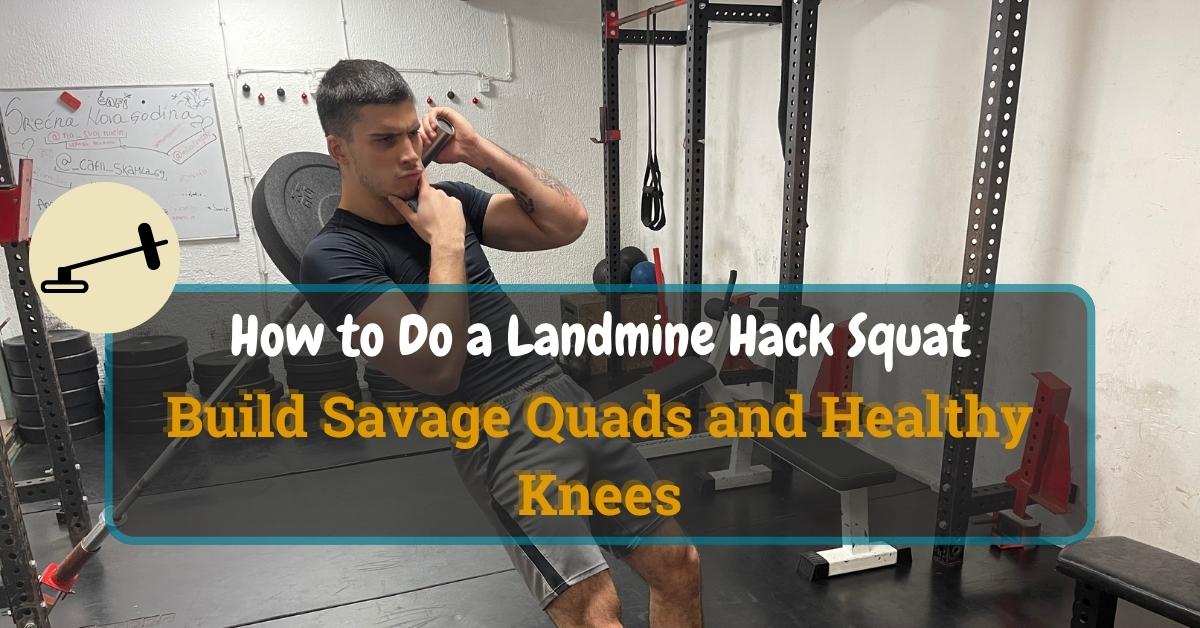The landmine hack squat is one of those exercises I regularly implement with my clients who need squat variations with reduced spinal load. What also makes this hack squat variation great is its inherent ability to target your quadriceps muscles naturally.
Table of Contents
ToggleAlso, even though the barbell may seem to have the freedom to move laterally, it is quite fixed in the landmine because of your body weight, which puts enough force to hold it in place. So, landmine hack squats are considered safe in terms of stability, at least in my experience.
In addition to that, you can’t really forget to mention their joint-friendly nature. This makes them great for individuals with knee or hip issues due to the unique angle and motion of the landmine.
In the sections below, I created a thorough landmine hack squat guide that covers exercise instructions, coach cues, programming principles, muscles worked, benefits, drawbacks, tips, common mistakes, and variations to try.
Buckle up and get ready to learn everything there is about landmine hack squats.
Start Building Your Dream Body Today
Ready to elevate your fitness game without falling into the trap of dull, repetitive routines that just don’t deliver? Imagine sculpting your ideal physique and boosting your health, all while still enjoying life’s pleasures, like those irresistible weekend getaways and your aunt’s legendary cheesecake. With our online fitness and nutrition coaching service, you don’t have to compromise. Dive into a personalized fitness journey that blends perfectly with your lifestyle, not against it. Book your completely free discovery consultation today, and take the first step towards a transformation that doesn’t require giving up the joys of life.

“I was skeptical about online fitness coaching, but Functional Body Savage completely changed my perspective. Vanja and Radomir’s personalized approach and attention to detail have helped me achieve goals I never thought possible. I’m stronger, more confident, and grateful for their guidance.”
Emily Thompson, San Francisco, CA
Learn More About Our Online Coaching ServiceQuick Summary
- To perform a landmine hack squat, secure a barbell in a landmine attachment, stand facing away with the barbell on one shoulder, squat down, maintain proper form, and then rise by driving through the feet.
- Key steps include setting up the equipment securely, adopting a stable starting position, engaging the core during the squat, and ensuring controlled movements throughout the exercise.
- A study found on PubMed Central involving 83 participants showed that volume load was associated with muscle hypertrophy in females and correlated with 1RM strength improvements in both sexes, highlighting the importance of tailored exercise programming.
- In my experience, consistent practice of landmine hack squats, with a focus on proper technique and gradual weight increase, leads to substantial improvements in quadriceps strength and overall lower body development.
How to Do a Landmine Hack Squat
Here is how to do a landmine hack squat with a barbell in a few simple steps.
Step One — Set Up a Landmine Attachment and a Barbell
Secure one end of a barbell in a landmine attachment or safely wedge it into a corner if you don’t have the attachment. Load the free end of the barbell with an appropriate amount of weight.
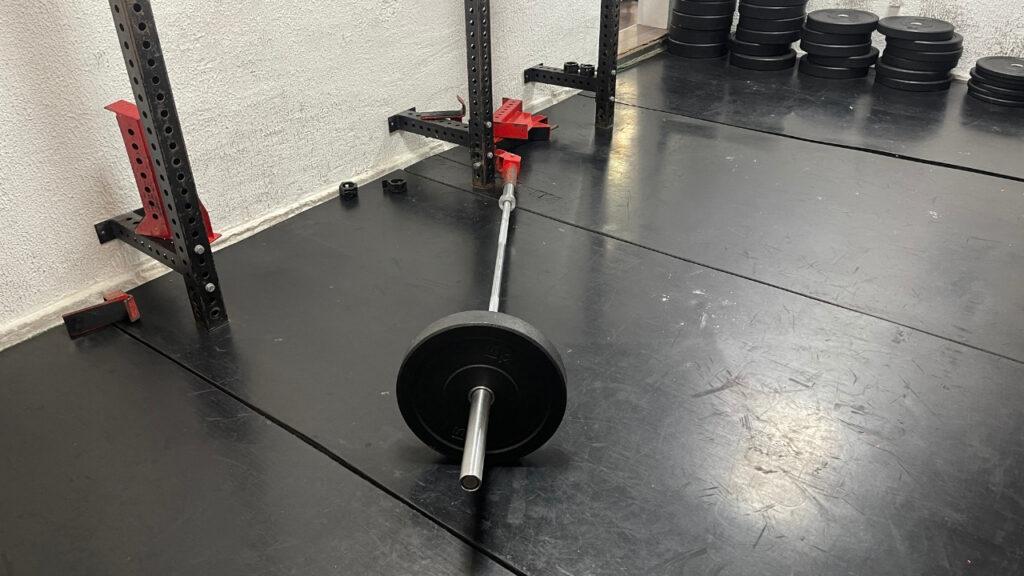
Pro Tip: Ensure the barbell is securely anchored to prevent it from slipping during the exercise. A stable setup is crucial for both the effectiveness and safety of the exercise.
Step Two — Assume the Starting Position
Stand facing away from the barbell, placing the free end on one of your shoulders. Your feet should be slightly wider than shoulder-width apart, with toes pointing slightly outward.
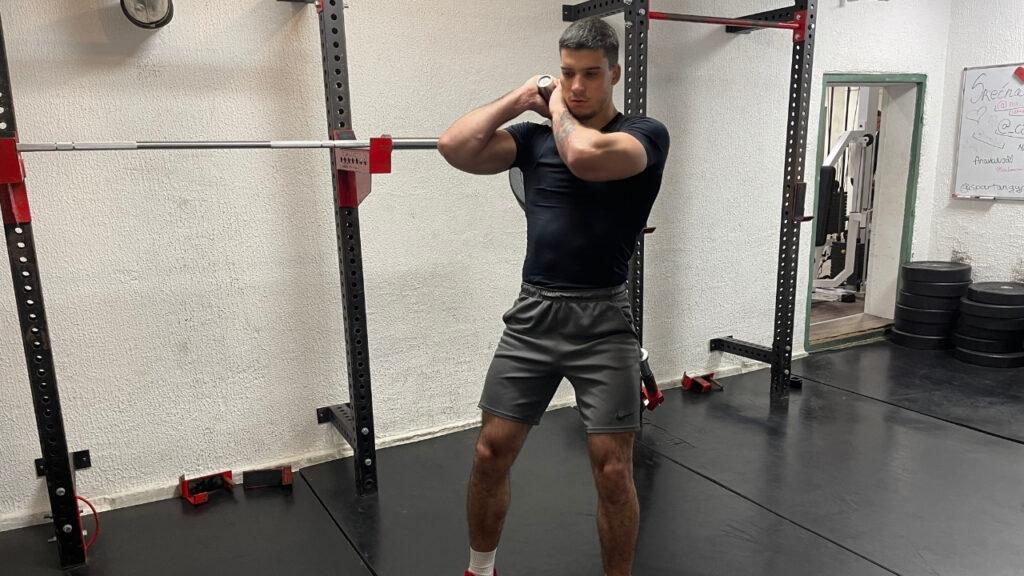
Pro Tip: Proper foot alignment is key. It helps in maintaining balance and ensures the correct muscles are targeted, reducing the risk of injury.
Step Three — Lower Your Body Into the Bottom Squat Position
Inhale as you slowly squat down by bending your knees and pushing your hips back. Keep your back straight and descend until your thighs are at least parallel to the floor or as far as your flexibility allows.
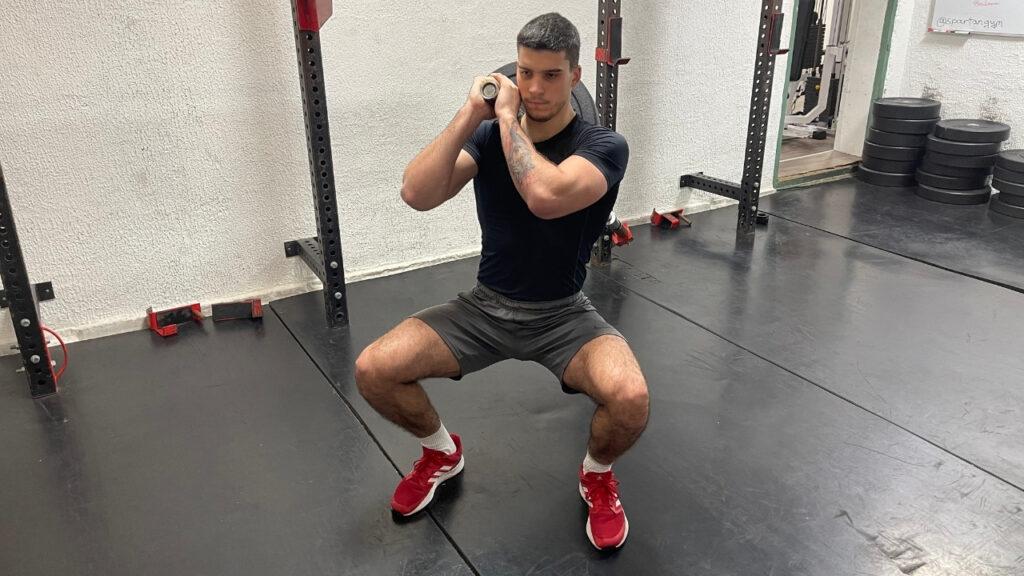
Pro Tip: Focus on keeping your core engaged and back straight to maintain balance and prevent strain on your lower back. This also ensures maximum engagement of the target muscles.
Step Four — Push Through the Balls of Your Feet
Exhale and drive through the balls of your feet to return to the starting position. Ensure your movements are controlled and steady.

Pro Tip: Pushing through the balls of your feet helps in activating the quadriceps more effectively. Avoid locking your knees at the top of the movement to maintain tension in the muscles.
Step Five — Safely Put the Barbell on the Floor After You Finish the Set
After completing your set, prepare to lower the barbell to the floor safely. Start by carefully turning 180 degrees, which will transition the barbell from resting on your shoulder to a position between your legs.
As you turn, keep your movements controlled and your core engaged to maintain balance. Once you are facing the barbell, begin to bend your knees and hinge at your hips, initiating a controlled descent of the barbell to the floor. Ensure your back remains straight and your core is engaged to support your spine throughout this movement.
Pro Tip: The 180-degree turn is a crucial step for a smooth transition and to position the barbell correctly for a safe descent. As you lower the barbell, focus on a slow and controlled movement.
How Should I Program Landmine Hack Squats?
I recommend incorporating landmine hack squats into your routine as an accessory lower body exercise, ideally 1-2 times per week. They’re particularly effective when placed in the middle or end of a leg-focused workout.
Start with 3 sets of 8-12 reps, focusing on proper form and controlled movements. Gradually increase the weight as you become more comfortable with the exercise.
Since they primarily target the quadriceps, complement them with exercises that focus on the hamstrings and glutes, like toes elevated Romanian deadlifts or hip thrusts, for balanced lower body development. Remember, consistency and progressive overload are key for seeing improvements, but always listen to your body and adjust as needed to avoid overtraining or injury [1].
In a study with 83 participants found on PubMed Central (43 males, 40 females; average age 25.12 ± 5.5 years) undergoing 12 weeks of unilateral arm resistance exercise, volume load (VL) was found to be independently associated with muscle hypertrophy only in females (β = 0.12; p < 0.01) [2].
For males, baseline strength was inversely related to hypertrophy (β = −0.12; p = 0.04), while VL strongly correlated with improvements in 1RM strength for both sexes (males β = 0.66, females β = 0.26; p < 0.01 and p = 0.02, respectively).
Additionally, volume load was only related to maximal voluntary contraction (MVC) improvements in females (β = 0.20; p = 0.02).
So, what is the conclusion of this study?
For both sexes, volume load is strongly correlated with improvements in one-repetition maximum (1RM) strength, reinforcing the idea that progressively increasing the workload is crucial for strength gains.
Landmine Hack Squat Weight: What Should I Start With?
I advise starting with a weight that allows you to perform landmine hack squats with proper form while still being challenging. For beginners, using just the barbell with the smallest plate (typically just above 45 pounds in total) is a good starting point. This helps in mastering all the important movement patterns without excessive strain.
As you gain strength and confidence in the exercise, gradually increase the weight. A good rule of thumb is to add weight in small increments (5-10 pounds) once you can comfortably complete your target sets and reps with good form.
Remember, the focus should be on technique and muscle engagement rather than lifting heavy, especially when you’re just starting out. Listen to your body and progress at a pace that feels challenging yet manageable.
Landmine Hack Squat Muscles Worked
The primary muscles working during landmine hack squats are:
- Quadriceps (vastus lateralis, vastus medialis, vastus intermedius, rectus femoris)
- Gluteal muscles (gluteus maximus, gluteus medius, gluteus minimus)
Also, the secondary muscles working during the same movement include:
- Hamstrings (biceps femoris, semitendinosus, semimembranosus)
- Core muscles (rectus abdominis, external obliques, internal obliques, transverse abdominis, erector spinae – iliocostalis, longissimus, spinalis)
- Adductors (adductor magnus, adductor longus, adductor brevis, gracilis)
- Calves (gastrocnemius, soleus)
- Upper back and shoulders (trapezius, rhomboids, deltoids)
Landmine Hack Squat Benefits
Below are all the hack squat benefits that you should be aware of.
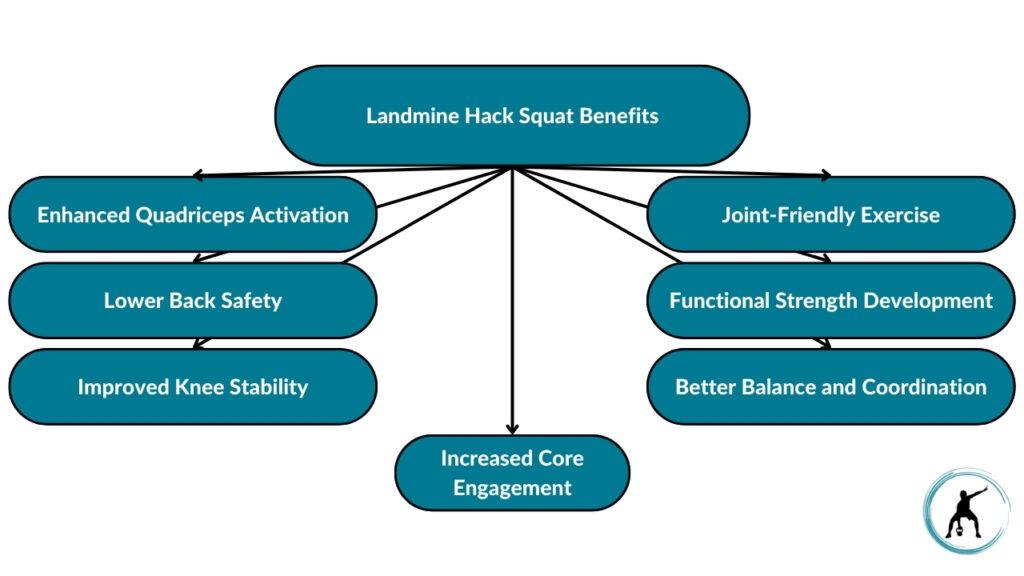
Enhanced Quadriceps Activation
Landmine hack squats specifically target the quadriceps, more so than many other squat variations. The angle and mechanics of the movement ensure that the quads are engaged intensely, leading to improved muscle strength and size in this key area.
Lower Back Safety
One of the standout benefits of this exercise is its lower back friendliness. Unlike traditional squats, the landmine hack squat reduces the load on your lower back, making it an excellent option for those with back sensitivities or for preventing back strain.
Improved Knee Stability
The unique positioning in landmine hack squats promotes a more vertical shin position, which can help in reducing shear forces on the knees. This is particularly beneficial for individuals looking to strengthen their knees without excess stress.
I use the landmine hack squat quite often in my workouts because I had issues with my knees in the past. Professional sports can get in the way of quite a lot of things these days.
Increased Core Engagement
Performing the landmine hack squat requires significant core stabilization. This engagement of the core muscles not only supports the lower back but also improves overall core strength and stability, which is crucial for functional fitness.
Better Balance and Coordination
This exercise challenges your balance and coordination, as it requires stabilizing the body while managing the asymmetric load of the barbell. Regular practice can lead to improved proprioception and body awareness, both essential for functional movement.
Functional Strength Development
Landmine hack squats mimic real-world movement patterns, making them highly functional. They contribute to the development of strength that translates into everyday activities and enhances sports performance.
Joint-Friendly Exercise
For individuals who find traditional squats or leg presses uncomfortable or painful, the landmine hack squat offers a joint-friendly alternative. The exercise allows for natural movement patterns and can be adjusted to suit various mobility levels, reducing the risk of joint discomfort.
Are There Any Drawbacks to Landmine Hack Squats?
Here are a couple of drawbacks I noted that are based on my experience and the ones I saw with my clients.
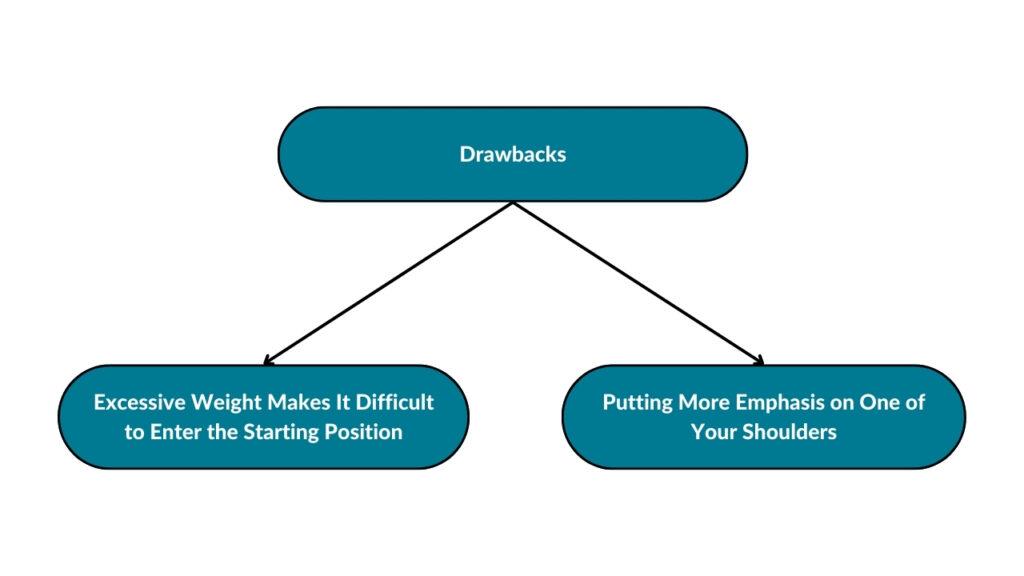
Excessive Weight Makes It Difficult to Enter the Starting Position
I’ve observed many clients struggling to get into the starting position of the landmine hack squat when using excessive weight.
This issue often arises because the exercise requires lifting the bar from the ground to a squat position, which can be challenging if the weight is too heavy. I’ve seen clients compromise their form, risking injury, just to get the bar into position.
To address this, I recommend starting with a lighter weight to master the technique. Focus on a full range of motion and proper form before gradually increasing the weight. Additionally, using a raised platform to place the barbell on can reduce the distance you need to lift it, making it easier to get into the starting position without compromising form.
Putting More Emphasis on One of Your Shoulders
One of the drawbacks is also the nature of the exercise, which makes it asymmetrical, putting more weight on one shoulder at a time. I’ve also noticed the tendency to distribute weight unevenly, putting more strain on one shoulder.
This often happens unconsciously and can lead to muscle imbalances or shoulder injuries over time. In my practice, I’ve also seen clients favoring one side, which not only affects their performance in the gym but also their posture and functional movements outside the gym.
To prevent this, it’s crucial to be mindful of maintaining even weight distribution throughout the exercise. I advise clients to actively engage both shoulders and keep their torso as straight as possible.
Incorporating unilateral exercises that target each shoulder independently can also help in developing balanced strength and awareness. Regularly checking the form in a mirror or recording your sessions can provide valuable feedback for maintaining symmetry.
What Are the Best Tips for Performing Landmine Hack Squats?
This exercise is a fantastic way to build strength and stability in the lower body. Still, it’s crucial to perform it correctly to maximize its benefits and minimize the risk of injury.
Here are some of the best tips for performing landmine hack squats so you can get the most out of the exercise.

Ensure the Barbell Is Securely Anchored
One of the primary concerns with landmine exercises is the stability of the barbell. An unsecured barbell can lead to accidents or ineffective movements.
In my training sessions, I always emphasize the importance of using a landmine attachment or wedging the barbell securely in a corner (protected with a towel or a rubber stopper to prevent damage).
Adopt a Stable Starting Position
The starting position is crucial for a successful landmine hack squat. I advise clients to stand with their feet shoulder-width apart and toes slightly pointed out. This stance provides a stable base.
It’s important to keep your back straight and engage your core throughout the movement. I’ve noticed that a strong starting position leads to a more effective and safer execution of the exercise.
Breathe Properly Throughout
Proper breathing is often overlooked, but it’s vital for performance and safety. Inhale as you lower into the squat and exhale as you push up.
This technique not only helps in maintaining rhythm but also aids in core stabilization, which is essential for any lifting exercise. I’ve seen significant improvements in my clients’ performances when they focus on their breathing patterns.
Progress Gradually With Weights
As with any strength training exercise, gradual progression is key. I often see individuals attempting to lift too heavy too soon, which can lead to poor form and injury.
Start with a weight that allows you to perform the exercise with proper form and gradually increase as you build strength and confidence.
Switch Sides for Balance and Symmetry
Since landmine hack squats can sometimes lead to uneven muscle development, it’s important to switch sides regularly. This ensures balanced muscle growth and symmetry. In my practice, I encourage alternating the shoulder that supports the barbell in each set or session.
This not only promotes muscular balance but also enhances overall body coordination.
What Are the Most Common Mistakes During Landmine Hack Squats?
Here are the most common mistakes during landmine hack squats.

Improper Foot Positioning
Foot positioning is crucial in landmine hack squats. Many individuals either place their feet too close together or too far apart. The ideal position is with feet shoulder-width apart and toes slightly pointed out. This stance provides stability and allows for proper muscle engagement.
Neglecting Core Engagement
A common oversight is failing to engage the core. Core engagement is essential for stability and power during the squat. I advise clients to actively tighten their abdominal muscles before descending into the squat.
This not only improves balance but also protects the spine, reducing the risk of lower back injuries.
Incorrect Weight Distribution
Weight distribution is key in this exercise. Often, individuals lean too far forward or backward, which can strain the back and knees. The weight should be evenly distributed across the feet, with a slight emphasis on the heels. I recommend practicing bodyweight squats to master this balance before adding weight.
Overloading the Barbell
Adding too much weight too soon is a frequent mistake. This can lead to compromised form and potential injury. It’s important to start with a manageable weight and focus on technique. Gradual progression in weight ensures a safer and more effective workout.
Not Achieving Full Depth
Achieving full depth in a squat is essential for activating the entire range of leg and glute muscles. A common mistake is performing shallow squats.
I encourage clients to squat down until their thighs are at least parallel to the ground, ensuring they maintain proper form throughout. This depth ensures maximum muscle engagement.
Rounding the Back
Rounding the back during a squat can lead to serious spinal injuries. It’s crucial to maintain a neutral spine throughout the movement.
I often remind clients to keep their chest up and shoulders back, which helps maintain a straight back. Strengthening the back and core muscles can also aid in maintaining proper posture.
Uneven Shoulder Placement
Uneven shoulder placement can lead to imbalances and potential strain. It’s important to distribute the weight across both shoulders evenly. I suggest alternating the shoulder that supports the barbell in each set or session to promote balance and symmetry. This practice not only prevents muscle imbalances but also enhances overall body coordination.
Landmine Hack Squat Variations and Alternatives
I listed below some landmine hack squat variations and alternatives I thought would be useful to include in your lower body workouts.
Single-Leg Landmine Hack Squat (Advanced Exercise)
Note: Please be cautious with this exercise. It is very advanced, and you will likely experience significant instability the first couple of times you do it.
The single-leg landmine hack squat focuses on unilateral strength, challenging balance, and coordination while targeting the quadriceps, hamstrings, and glutes on one leg at a time.
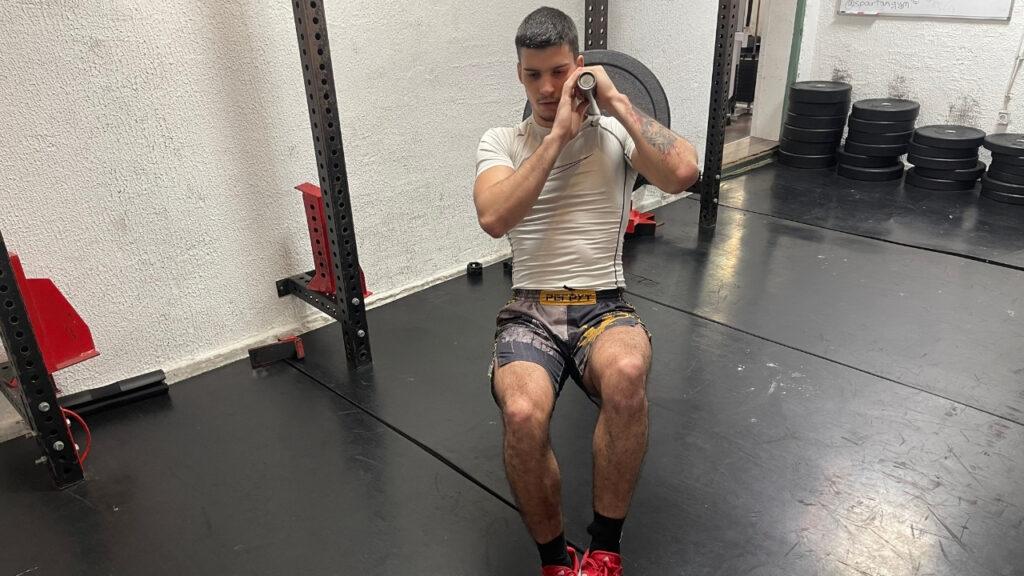
Instructions:
- Stand with your feet hip-width apart, facing away from the barbell, placing the free end on one of your shoulders.
- Lift one foot off the ground, balancing on the other leg.
- Lower into a squat on your standing leg, keeping your chest up and back straight.
- Push through your heel to return to the starting position.
- Repeat for desired reps before switching legs.
Pro Tip: Focus on maintaining balance and control throughout the movement, avoiding any rush. This exercise is not just about strength but also about stability and control, so consider using a lighter weight than you would for a standard hack squat.
Landmine Sumo Squat
The landmine sumo squat targets the inner thighs, glutes, and quads with a wider stance that emphasizes adductor and hamstring engagement. You can also consider doing an elevated sumo squat for a deeper stretch of your adductors and glutes.
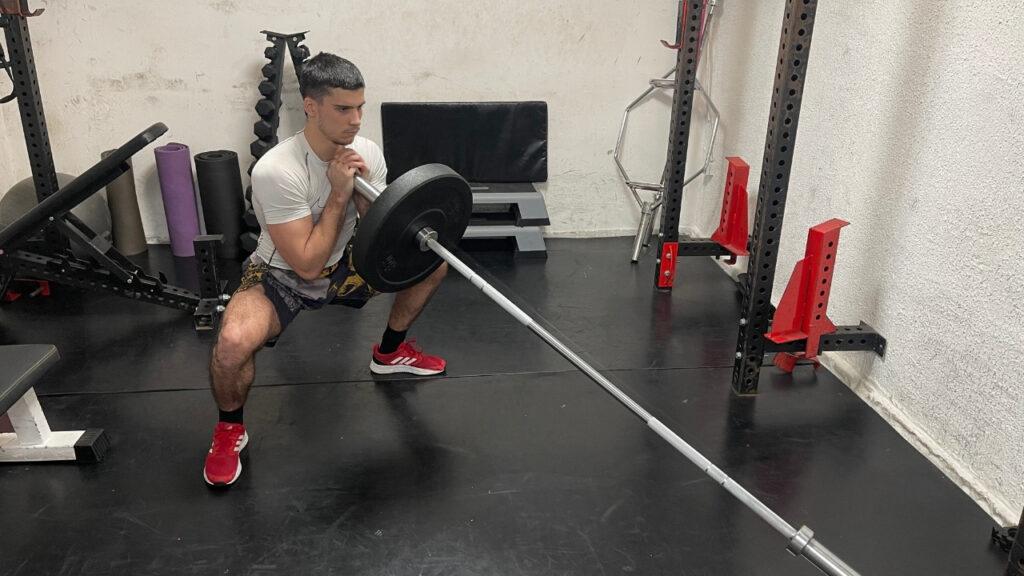
Instructions:
- Stand with your feet wider than shoulder-width apart, toes pointed outwards.
- Hold the end of the barbell with both hands at chest level.
- Keeping your back straight and chest up, lower into a deep squat.
- Push through your heels to return to the starting position.
- Repeat for the desired number of repetitions.
Pro Tip: Ensure your knees are aligned with your toes throughout the squat to avoid knee strain. Engage your glutes and inner thighs as you rise to maximize the effectiveness of the exercise.
Landmine Squat to Press
The landmine squat to press is a compound movement that combines a squat with an overhead press, engaging the lower body, core, and shoulders.
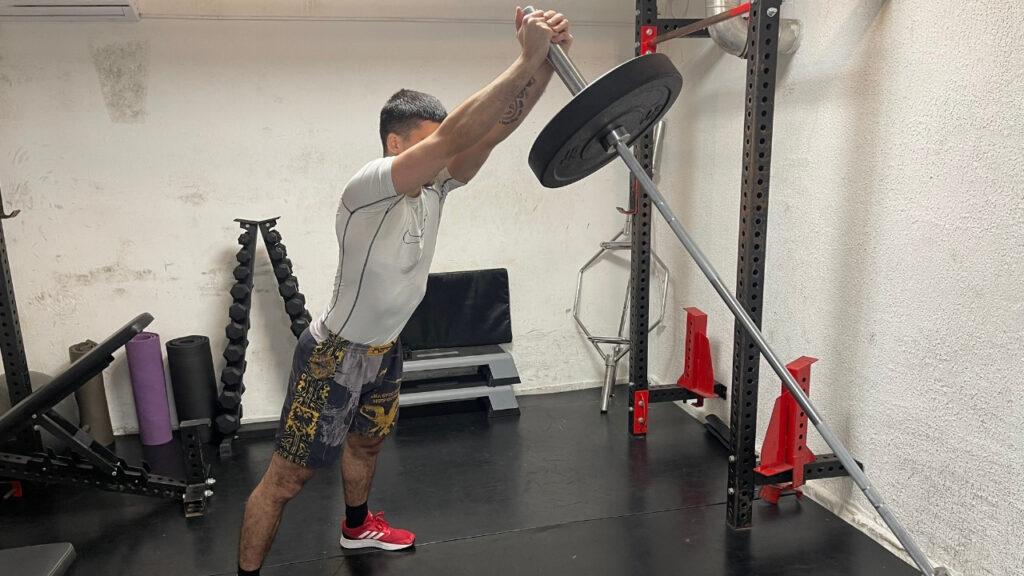
Instructions:
- Stand with feet shoulder-width apart, holding the barbell with both hands at shoulder level.
- Perform a squat, keeping your back straight and chest up.
- As you rise from the squat, transition into an overhead press by extending your arms.
- Lower the barbell back to shoulder level as you move into the next squat.
- Repeat for the desired number of repetitions.
Pro Tip: Coordinate your movement so that the momentum from standing up assists with the overhead press. This exercise is great for building functional strength, so focus on fluidity and control.
Landmine Front Squat
The landmine front squat emphasizes the quads and upper back, offering a unique variation to the traditional front squat by reducing stress on the wrists and shoulders.
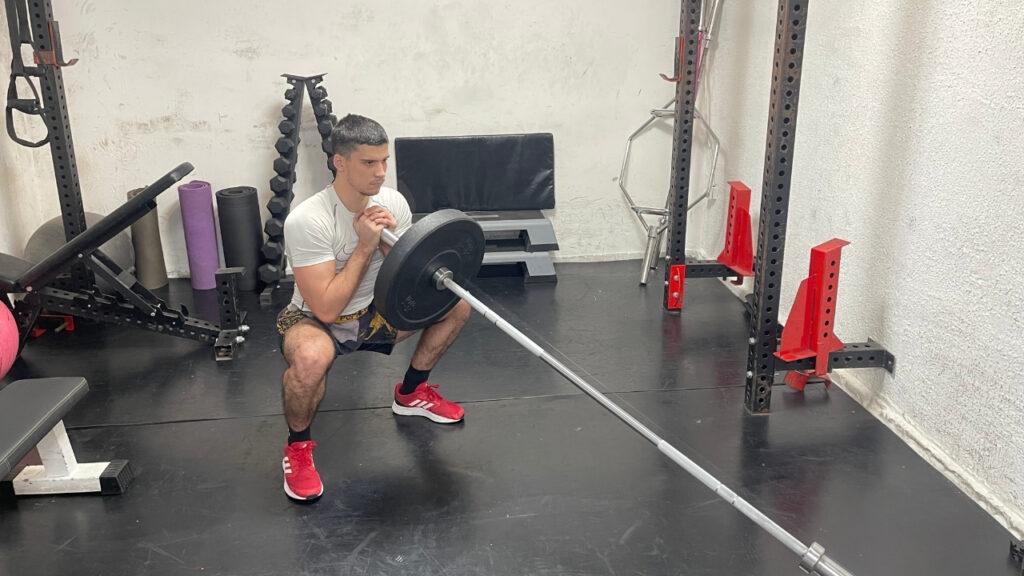
Instructions:
- Stand with feet shoulder-width apart, holding the barbell with both hands at chest level.
- Keep your elbows high to maintain the barbell in position.
- Perform a squat, ensuring your back remains straight and your chest stays up.
- Drive through your heels to return to the starting position.
- Repeat for the desired number of repetitions.
Pro Tip: Maintain a high elbow position throughout the squat to keep the barbell stable and reduce strain on your arms. This variation is particularly beneficial for those with limited mobility in their shoulders or wrists.
FAQs
How Do You Get Into a Landmine Hack Squat?
To get into the starting position of a landmine hack squat, begin by standing with the barbell end on the floor near your feet. Bend at the hips and knees to squat down, and position the barbell over one shoulder, as you turn 180 to turn your back to the landmine attachment and barbell. Ensure your feet are shoulder-width apart, and align your body so that the weight is evenly distributed, preparing to lift the barbell for the squat.
What Are the Cues for Landmine Hack Squats?
The cues for landmine hack squats include keeping your feet flat and shoulder-width apart, maintaining a straight back, engaging your core, and ensuring your chest stays lifted throughout the movement. Additionally, focus on driving through your heels as you stand up to maximize the effectiveness of the exercise.
Is the Landmine Hack Squat Safe?
The landmine hack squat is generally safe when performed with proper form and an appropriate weight for your fitness level. It is important to avoid rounding your back, overloading the barbell, and ensuring the barbell is securely anchored to prevent injury.
What Is the Difference Between Landmine Hack Squat and Leg Press?
The difference between the landmine hack squat and leg press lies in the equipment used and the body position during the exercise. The landmine hack squat is performed with a barbell and engages the core and stabilizer muscles more actively. At the same time, the leg press is done on a machine, primarily targeting the quadriceps and glutes with less core engagement.
What Is the Difference Between Landmine Squats and Landmine Hack Squats?
The difference between landmine squats and landmine hack squats is primarily in the positioning of the body and the barbell. In landmine squats, the barbell is held in front of the body, engaging the upper back and shoulders more. In landmine hack squats, the barbell is positioned on one of your shoulders while you are facing away from the barbell, placing more emphasis on the lower back and legs.
Wrapping Up
The landmine hack squat is a versatile and effective exercise that offers numerous benefits, especially for those seeking a lower-body workout that is kind on the joints and spine. Its unique mechanics target the quadriceps intensely while also engaging the core and stabilizing muscles, making it a valuable addition to any fitness regimen.
Whether you’re a beginner or an experienced athlete, incorporating this exercise into your routine can lead to significant improvements in strength, balance, and overall functional fitness. Remember to start with manageable weights, focus on proper form, and gradually progress to ensure safety and effectiveness.
Start Building Your Dream Body Today
Ready to elevate your fitness game without falling into the trap of dull, repetitive routines that just don’t deliver? Imagine sculpting your ideal physique and boosting your health, all while still enjoying life’s pleasures, like those irresistible weekend getaways and your aunt’s legendary cheesecake. With our online fitness and nutrition coaching service, you don’t have to compromise. Dive into a personalized fitness journey that blends perfectly with your lifestyle, not against it. Book your completely free discovery consultation today, and take the first step towards a transformation that doesn’t require giving up the joys of life.

“I was skeptical about online fitness coaching, but Functional Body Savage completely changed my perspective. Vanja and Radomir’s personalized approach and attention to detail have helped me achieve goals I never thought possible. I’m stronger, more confident, and grateful for their guidance.”
Emily Thompson, San Francisco, CA
Learn More About Our Online Coaching ServiceReferences:
- Kreher JB, Schwartz JB. Overtraining syndrome: a practical guide. Sports Health. 2012;4(2):128-138. doi:10.1177/1941738111434406
- Peterson MD, Pistilli E, Haff GG, Hoffman EP, Gordon PM. Progression of volume load and muscular adaptation during resistance exercise. Eur J Appl Physiol. 2011;111(6):1063-1071. doi:10.1007/s00421-010-1735-9

